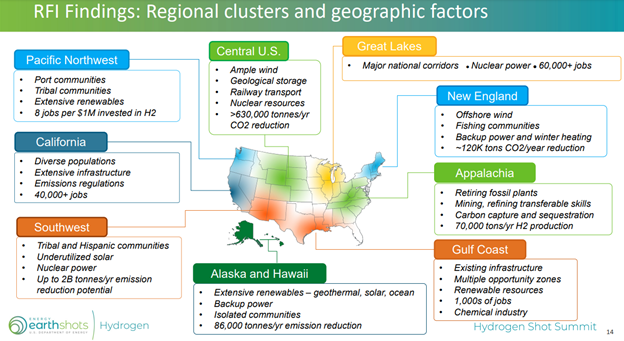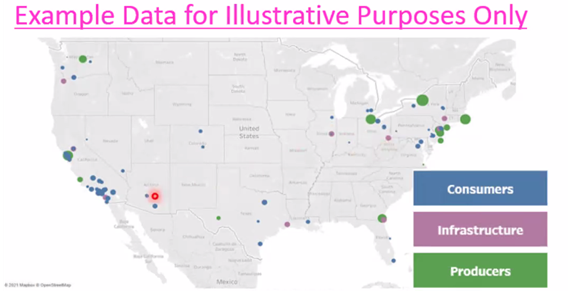Media Coverage 11.16.21
New U.S. Department of Energy Office Could Help Bridge 'Valley of Death' for Clean Energy Technologies
Source: S&P Global Market Intelligence
Alert
Alert
12.21.21
On December 8, 2021, the Department of Energy (DOE) Hydrogen Program hosted a public webinar and shared several program updates on the DOE’s Hydrogen Earthshot initiative. This included the results of the program’s June 2021 Request for Information (RFI) on potential U.S. locations that could support near-term, large-scale, clean hydrogen demonstration projects, as well as the launch of a new tool called H2 Matchmaker, to facilitate clean hydrogen hub formation. These updates are crucial for entities interested in participating in the $9.5 billion of hydrogen programs recently passed as part of the Infrastructure Investment and Jobs Act (IIJA). We summarize the highlights below.
I. DOE Identifies Regional Clean Hydrogen Clusters in its RFI Results
The DOE received over 200 responses to its RFI issued in the summer of 2021, which was targeted on identifying near-term clean hydrogen demonstration sites in the U.S. The DOE Hydrogen Program presented the consolidated results of those responses on December 8, 2021, and divided the U.S. into nine (9) regional clean hydrogen clusters: Pacific Northwest, California, Southwest, Central U.S., Great Lakes, New England, Appalachia, Gulf Coast, and Alaska and Hawaii. Considerations for each region aligned with the priorities identified for regional clean hydrogen hub selection in the IIJA, including resources (renewables, nuclear, hydropower, etc.), influences (population, current emissions, cost, etc.), and end uses (transport, ports, rail, electricity, etc.).

The results of this RFI should inform entities interested in participating in the DOE’s $8 billion Regional Clean Hydrogen Hub Program, for which the Secretary is required to solicit proposals by May 15, 2022. The IIJA requires the DOE to select “at least” four (4) regional clean hydrogen hubs across the U.S., so the total number selected could be higher.
Notable in the DOE presentation was the focus on the potential for nuclear-derived hydrogen—it was mentioned for seven (7) out of the nine (9) regions (excluding only California and Appalachia) as a potential resource. The IIJA requires at least one of the regional clean hydrogen hubs is required to demonstrate hydrogen production from nuclear, one from fossil fuels, and one from renewables, as the Pillsbury hydrogen team previously covered here. However, the IIJA’s language only requires this from “at least” one of the hubs, so multiple hubs could demonstrate diversified production technologies. In terms of renewables, the Pacific Northwest and Alaska and Hawaii were identified as having extensive renewable resources, while California was identified as already having 48 hydrogen fueling stations available in the state.
Another highlight was the RFI’s focus on the potential for job creation in each region. This aligns with the statutory requirement that the Secretary give priority to the selection of hubs that are likely to create long-term employment for “the greatest number of residents” in the region.
There is no doubt that the results of this RFI will be instrumental in informing the DOE while it develops a National Clean Hydrogen Strategy and Roadmap as required by the IIJA and due to Congress by May 15, 2022. Interested parties can view the full detailed presentation here.
II. DOE Launches “H2 Matchmaker” to Facilitate Hub Formation
In order to better connect producers, consumers, and infrastructure operators in different regions, the DOE is launching a new tool called “H2 Matchmaker.” This is an interactive online map in which entities can voluntarily submit information on their hydrogen projects in order to be connected with other producers, consumers, and infrastructure operators within their geographic vicinity. This approach aligns with the definition of a clean hydrogen hub in the IIJA itself, which defines a hub as “a network of clean hydrogen producers, potential clean hydrogen consumers, and connective infrastructure located in close proximity.”

The website is now live in skeletal form and will soon contain a link to complete and submit the H2 Matchmaker online form. Companies interested in participating in DOE hydrogen programs can complete the form available on the website in order to connect with potential hub partners. We note, however, that companies should only input information into the form that is not proprietary, as all of this information will be imported into the public H2 Matchmaker tool.
If you are interested in a global map of hydrogen projects, Pillsbury’s dedicated hydrogen team hosts The Hydrogen Map, the first public resource tracking the development of hydrogen projects worldwide.
As a globally recognized law firm leader in the energy transition, more than a year ago Pillsbury launched its Hydrogen practice. One of the first Hydrogen practices launched by an AmLaw 100 firm, Pillsbury’s Hydrogen team has a deep understanding of hydrogen-based energy technologies and stands ready to advise clients across all sectors on its vast potential. Read more here.